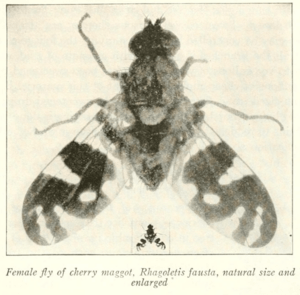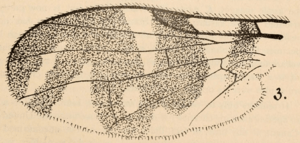Black-bodied cherry fruit fly facts for kids
Quick facts for kids Black-bodied cherry fruit fly |
|
|---|---|
 |
|
 |
|
| Scientific classification | |
| Kingdom: | |
| Phylum: | |
| Class: | |
| Order: | |
| Section: |
Schizophora
|
| Subsection: |
Acalyptratae
|
| Superfamily: |
Tephritoidea
|
| Family: | |
| Genus: |
Rhagoletis
|
| Species: |
R. fausta
|
| Binomial name | |
| Rhagoletis fausta (Osten Sacken, 1877)
|
|
| Synonyms | |
|
|
The black-bodied cherry fruit fly, known scientifically as Rhagoletis fausta, is a small insect. It belongs to a group of flies often called fruit flies. This specific fly is found in parts of the United States and Canada. It's known for its dark body and its connection to cherry trees.
What is a Fruit Fly?
Fruit flies are tiny insects that belong to the family Tephritidae. Many of them are known for laying their eggs in fruits. The larvae, or young flies, then grow by eating the fruit. There are many different kinds of fruit flies. Some are helpful, and some can be pests to farmers.
Rhagoletis fausta is a type of fruit fly. It has a dark, almost black body. Its wings often have unique patterns. These patterns help scientists tell different types of flies apart.
Where Do They Live?
The black-bodied cherry fruit fly lives in North America. You can find it in both the United States and Canada. These flies are usually found where their favorite food source grows. For Rhagoletis fausta, this means places with cherry trees. They are often seen near orchards or wild cherry trees.
Life Cycle of the Fly
Like many insects, the black-bodied cherry fruit fly goes through a complete life cycle. This cycle includes four main stages:
- Egg: The adult female fly lays tiny eggs. She usually places them inside ripening cherries.
- Larva: After hatching, the eggs become larvae. These are small, worm-like creatures. They feed on the fruit from the inside. This is how they get the energy to grow.
- Pupa: Once the larva is fully grown, it leaves the fruit. It then burrows into the soil to become a pupa. This is a resting stage. Inside the pupa, the larva changes into an adult fly.
- Adult: Finally, the adult fly emerges from the pupa. The adult flies then mate and lay eggs. This starts the cycle all over again.
Adult flies feed on sweet liquids. These can be nectar from flowers or juices from fruits.
How Scientists Study Flies
Scientists study insects like Rhagoletis fausta to understand nature better. They give each species a unique scientific name. This helps scientists around the world know exactly which creature they are talking about.
The black-bodied cherry fruit fly was first described in 1877. A scientist named Carl Robert Osten-Sacken gave it its first name. He placed it in a different group of flies back then. Later, in 1899, another scientist, Daniel William Coquillett, moved it to the Rhagoletis group. This is the group it still belongs to today.
Sometimes, scientists describe the same animal more than once. This happened with Rhagoletis fausta. In 1909, John Merton Aldrich described a fly he called R. intrudens. But the next year, he realized it was the same as Rhagoletis fausta. So, R. intrudens became a "junior synonym." This means it's a different name for the same species.
Studying these flies helps us learn about their role in nature. It also helps us protect plants and ecosystems.

